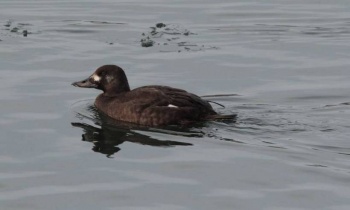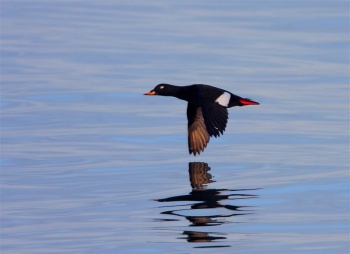- Melanitta fusca
Identification
Length 51-58cm (20-22¾ in), weight 1200-1800 g
Male
- Black overall plumage
- White 'tick' just below and behind the eye
- Long yellow bill
- Thick neck
- Pointed tail
Female
- Dusky brown upperparts
- Scaly-looking brownish-grey underparts
- Two pale spots in the head, one on the auriculars, one between eye and bill
Juvenile a paler version of female
Notes on distinguishing males of Velvet, White-winged, and Stejneger's Scoter

Photo © by Digiscoper321
Western Sweden, 3 April 2015
- M. fusca: the least knob on the bill, and the least white around and behind the eye; almost no white above the eye. The coloured section of the bill is yellow and relatively long, and the distance from the base of that to the eye is short, producing the impression that the eye is positioned relatively far forward on the head. The crown looks highest above the eye.
- M. deglandi: clear knob at the base of the bill, with the yellow-orange part relatively short, so that the eye looks set further back on head than M. f. fusca. The white around the eye is shaped as a checkmark, pointed up at the rear end. The coloured part of the bill is orange with the top parts looking yellow. The crown is highest in front of the eye. When seen well, flanks will be brown in contrast to black back and breast.
- M. stejnegeri: Head shape closer to Common Eider in shape, with a long, sloping forehead. White around eye similar to or longer than M. deglandi. It has a clear knob - almost like a small Rhinoceros horn - on the bill, further forward than M. deglandi, and the coloured parts are mostly red with yellow "lipstick" below. Flanks are black
Females are much harder to distinguish, only determinable at the closest range; M. fusca has a slightly concave forehead with no basal swelling on the bill, M. stejnegeri a slightly swollen bill base, and M. deglandi a marginally more swollen bill base.
Flight
In flight, it shows a white patch on the rear of the wing.
Distribution
Breeds from Scandinavia and Estonia east to River Yenisey, in central Siberia and south to Kazakhstan. Isolated populations in Georgia, Armenia and Turkey.
Winters along the coasts of Western Europe south to the Mediterranean and Black and Caspian Seas.
Taxonomy
This is a monotypic species1.
Formerly considered conspecific with White-winged Scoter from North America and Stejneger's Scoter from northeastern Asia.
Habitat
Breeds around fresh water bodies near boreal forests and arctic tundra; sometimes far from the coast.
Outside of the breeding season, they are to be found in coastal waters, often near shellfish beds
Behaviour
Often mixes with with Common Eider, and sometimes with Common Scoter.
Action
Slower and more powerful than Common Scoter.
Diet
Their diet includes shellfish, crabs, sea urchins, fish, insect larvae and plants.
Breeding
They build a lined nest on the ground near lakes or rivers, in woodland or tundra. The clutch consists of 7-9 eggs.
Vocalisation
References
- Clements, J. F., T. S. Schulenberg, M. J. Iliff, S. M. Billerman, T. A. Fredericks, B. L. Sullivan, and C. L. Wood. 2019. The eBird/Clements Checklist of Birds of the World: v2019. Downloaded from http://www.birds.cornell.edu/clementschecklist/download/
- Gill F, D Donsker & P Rasmussen (Eds). 2020. IOC World Bird List (v10.1). doi : 10.14344/IOC.ML.10.1. Available at http://www.worldbirdnames.org/
- DUDLEY et al. 2006. The British List: A Checklist of Birds of Britain (7th edition). Ibis 148:526–563 with online updates to 2009
- Carboneras, C., Kirwan, G.M. & Sharpe, C.J. (2020). Velvet Scoter (Melanitta fusca). In: del Hoyo, J., Elliott, A., Sargatal, J., Christie, D.A. & de Juana, E. (eds.). Handbook of the Birds of the World Alive. Lynx Edicions, Barcelona. (retrieved from https://www.hbw.com/node/52922 on 8 April 2020).
- R Strack 2010. Fløjlsænder. Fugle i Felten 1: 6-7, January 2010 (in Danish) .
- Grant, P.J., K. Mullarney, L. Svensson, D. Zetterstrom (1999) Collins Bird Guide: The Most Complete Field Guide to the Birds of Britain and Europe. Harpercollins Pub Ltd ISBN 0 00 219728 6
- Peterson, RT, G Mountfort and PAD Hollom. 1993. Collins Field Guide – Birds of Britain and Europe, 5th Revised edition. London: HarperCollins Publishers. ISBN 978-0002199001
- Carboneras, C., G. M. Kirwan, and C.J. Sharpe (2020). Velvet Scoter (Melanitta fusca), version 1.0. In Birds of the World (J. del Hoyo, A. Elliott, J. Sargatal, D. A. Christie, and E. de Juana, Editors). Cornell Lab of Ornithology, Ithaca, NY, USA. https://doi.org/10.2173/bow.whwsco3.01
Recommended Citation
- BirdForum Opus contributors. (2024) Velvet Scoter. In: BirdForum, the forum for wild birds and birding. Retrieved 19 April 2024 from https://www.birdforum.net/opus/Velvet_Scoter
External Links
GSearch checked for 2020 platform.






